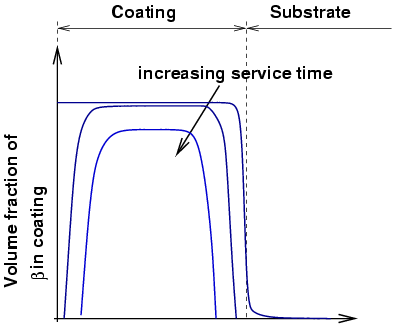

Schematic illustration of MCrAlY microstructure.
Al diffusion to the oxide layer and the substrate result in depletion of beta from both sides.
| Introduction | Bond Coats | TBC | Processes | Resources | |
| [Introduction] [Aluminides] [Pt-Aluminides] [MCrAlY] | Back to phase-transformation home page |
As discussed in previous sections, aluminide coatings strongly interact with the substrates and must therefore be tailored for each different alloy.
Overlay coatings as opposed to diffusion coatings, provide more
independence from the substrate alloy, but also more flexibility in design as
compositions can be modified depending on the degradation mechanisms expected to
prevail.
Typical MCrAlY bond coats (M=Fe,Co or Ni) contain at least 4 elements,
which means that coating methods such as pack cementation are considerably more
difficult to use, as the activity of each element in the pack would have to be
controlled carefully so as to obtain a coating of required composition.
The presence of a significant amount of Cr give these coatings excellent corrosion resistance combined with good oxidation resistance.
Alternative methods are therefore preferred, such as air plasma spray (APS), low pressure plasma spray (LPPS), or electron beam physical vapour deposition (EBPVD). These are detailed in other sections. Deposition is followed by a high-temperature heat-treatment in vacuum to allow interdiffusion and therefore improve adhesion (for example, Richard 1996) .
MCrAlY coatings typically exhibit a two-phase microstructure
As for
 |
 |
Schematic illustration of MCrAlY microstructure. |
Al diffusion to the oxide layer and the substrate result in depletion of beta from both sides. |
The M of MCrAlY stands for either Ni or Co, or a combination of both (when applied to steels, it can also be Fe), depending on the type of superalloy. Co-based appear to have superior resistance to corrosion.
Cr provides hot-corrosion resistance, but the amount that can be added is limited by the effect it is expected to have on the substrate, and the formation of Cr-rich phases in the coating.
Al content is typically around 10-12 wt%. Since oxidation life is essentially controlled by the availability of Al, it would be tempting to increases the alulminium content. However, this results in significant reduction of ductility (for example, Sivakumar, 1989).
MCrAlY also typically contain 1 wt% yttrium (Y), which enhances adherence of the oxide
layer. It was initially thought that Yttrium helped the formation
of oxide pegs which helped anchor the oxide layer to the coating.
However, it has been shown that there is little if any correlation (Smeggil,
1987), and it is now believed that the main role of Y is to combine with sulfur
and prevent its segregation to the oxide layer, which is otherwise detrimental
to its adhesion.
Additions of hafnium (Hf) play a similar role
The effect of other additions has also been investigated (Nicoll, 1982). It was found that silicon (Si) significantly improved cyclic oxydation resistance, however it also decreases the melting point of the coating. 5 wt% are enough to lower the melting temperature to about 1140 oC. There is also evidence that it affects phase stability. For cyclic oxidation at 1000 oC, 2.5 wt% was found to be the optimum content. Further additions were detrimental.
Additions of rhenium (Re) have been shown to improve isothermal or cyclic oxidation resistance, and thermal cycle fatigue (Czech et al., 1994).
Additions of tantalum (Ta) can also increase the oxidation resistance.
| conditions of use | 2004 Thomas Sourmail. | Feedback greatly appreciated |